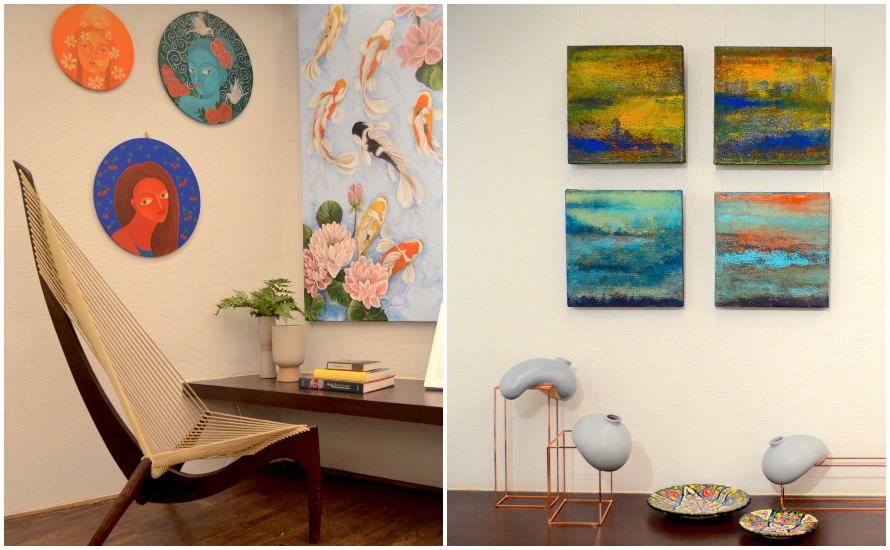 “Buying is a profound pleasure”, said Simone de Beauvoir, while Nora Huime says, “Buying art is like falling in love”. To many collectors, buying, collecting, acquiring and the pursuit of the object become an intense passion. “Collecting at its best is very far from mere acquisitiveness; it may become one of the most humanistic of occupations, seeking to illustrate by the assembling of significant reliques, the march of the human spirit in its quest for beauty… “(Arthur Davison Ficke)
“Buying is a profound pleasure”, said Simone de Beauvoir, while Nora Huime says, “Buying art is like falling in love”. To many collectors, buying, collecting, acquiring and the pursuit of the object become an intense passion. “Collecting at its best is very far from mere acquisitiveness; it may become one of the most humanistic of occupations, seeking to illustrate by the assembling of significant reliques, the march of the human spirit in its quest for beauty… “(Arthur Davison Ficke)
Many important collections find their way to museums. The old idea of the cabinet of curiosity originated when travelers to the Orient went back to Europe with curiosities that intrigued rich patrons and thus was born a museum. This need to do something with their objects developed further into an idea with a subject and hence the many museums we have today are of different disciplines. Today’s art collectors face similar quandaries and many new private museums will appear in India in the years to come to be final custodians of these pieces of history. These repositories are a result of passionate collectors who focus entirely with their heart and have an intellectual relationship with what they collect. They often live with objects that they love, getting intense pleasure from their presence. These maybe inanimate objects but the memory, history and narrative of the object sparks a fire that ignites this passion and hence the feverish accumulation.
In Chennai, VAK Ranga Rao is known for his collection of records, while the Roja Muthiah library is a result of a fantastic collection of literature. C Ramakrishna, a lawyer has started an arboretum, that is a collection of trees and Lily Vijayaraghavan has focused her decorative arts collection on Shringar. A local newspaper has been focusing periodically on quirky interesting collectors with varied themes ranging from pens to cameras to matchbox labels and so on. The common factor amongst all of them is their intense passion, love and involvement in building and nurturing their collections. These collections vary in depths and yet are chronicles of a time.
On the other hand there are collectors especially of contemporary art, who collect as an investment. They focus only on artworks that bring them a return on investment, while they hold it. Their aim is to make a profit while reselling the work. For investor collectors, their research will involve authenticity, provenance, condition and the history and geography of that particular work as all these points become relevant in a resale. They too live with their art, though larger collections find their way to storages. The need for investor collectors to circulate, update and continue to build their collections allows them to release some of their art works to the market and this then, becomes the secondary market.
Paul Getty the famous collector once said, “I buy when other people are selling”. The collector attempts always to acquire the best, and his knowledge of what is best is always widening. His is the task of judging between degrees of perfection. The collector is not looking for a decorative item, but a good investment. There is some aspect of the work itself that has allowed the price of the work to be determined. The history of the work is also about the story – the story behind how someone found it and who the artist was and what he did with his life and why he caught the fancy of ” a ” collector or a group of collectors and why they purchased it.. Often while focusing on a particular artist, collectors know that earlier works are hard to come by and scoring the secondary market allows for this search to be quite meaningful. The secondary market historically depends on rarity and a lack of availability to create a demand. An interesting aspect of this is that a “strong” secondary market trade allows collectors to buy “as well as” sell.
In India, most collectors of art have been wealthy patrons who bought initially to adorn their spaces and eventually turned to support the artists and their movement. The earliest known collectors of contemporary art were mostly around Bombay. Naval Vakil, Bill Choudhary and JRD Tata, were some of the earliest contemporary art collectors. Jungoo Nicholson, another passionate collector acquired a substantial part of his legendary collection from Bill Choudhary in lieu of a debt. The legendary TIFR and Taj Hotel collection was a result of the patronage of the Tatas. The Birlas in Eastern India, initially collected traditional art and moved to contemporary art much later. One of the most significant new media collections in India is that of Devi Foundations. (Lekha Poddar, one of Devi’s main forces is a Birla daughter). These collectors were followed by many others and now collecting art has become such a status symbol that it has helped many attain a status that they would not been able to, but for their collections.
One of the most important aspects for investor collectors is valuation and this is provided for by several galleries, websites and auction houses. While galleries help in building and nurturing an artist, acting like a bridge between the artist and the collector, the auction businesses are involved purely in the trade.
Building a collection is an important activity. It is important to be a significant collector and focus one’s collection, to find a direction in the vast sea of objects and art works. Be it a relationship, or a subject of interest, one needs a hook, as a link, to steer one through on the journey of becoming and staying a collector while building an important adjunct to cultural history. Art and culture are great facets of history and very soon collectors with relevant focuses will find their place in the trajectory of culture. Collection may be a selfish passion when viewed at its acquisitive culture. However its element of documentation of a time, is a facet that is highly undervalued.
To collectors, be it passion driven, or investment driven, the visibility and pride in their collection is of utmost importance. Like the proud mother of a newborn baby, each collector holds out his newest acquisition and each investor lauds the price he got on a resale. Collecting is a bug – once it gets you, it stays. The excitement, the intensity, the disappointments, the sharing- showing off is all part of the game. The joys know no bounds and sorrows are few, while the legacy and chronicle a collector creates is immeasurable to cultural history.







 Raashii Khanna
Raashii Khanna










